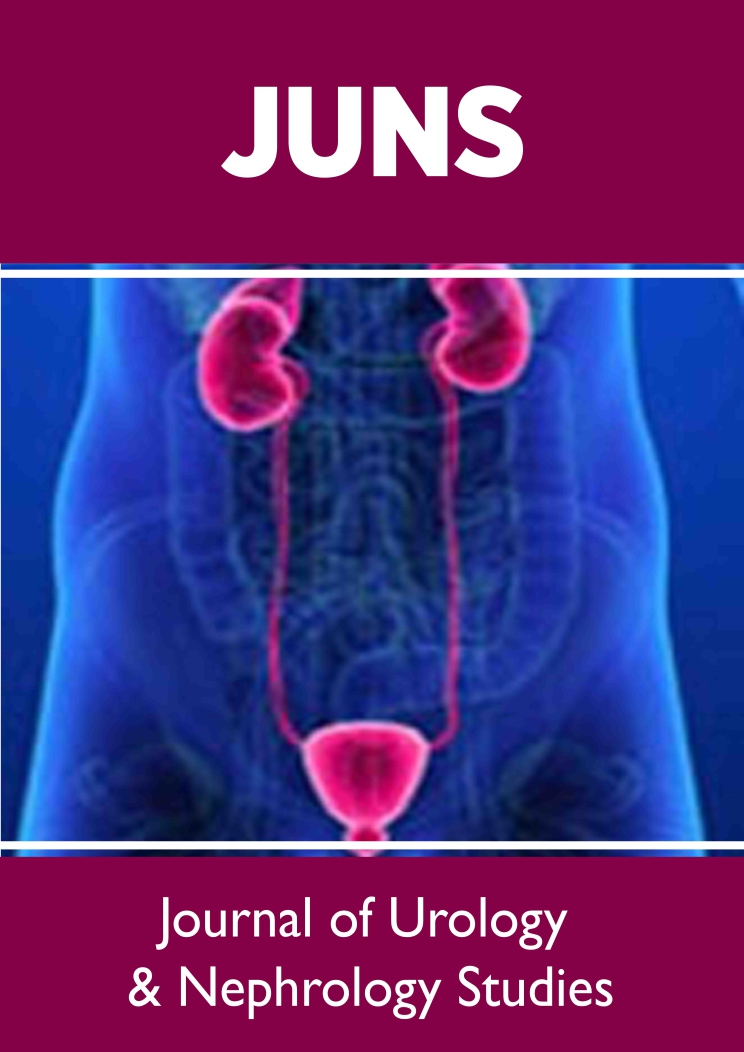
Lupine Publishers Group
Lupine Publishers
Menu
ISSN: 2641-1687
Research Article(ISSN: 2641-1687) 
Effect of Total Saponins and Tannins Isolated from Dialium guineense Stem Bark on Oxidative Status in Rats Exposed to CCl4 Volume 4 - Issue 4
Abu OD1*, Omage JI2 and Ogbebor EO3
- 1Department of Biochemistry, Faculty of Life Sciences, University of Benin, Benin City, Nigeria
- 2Department of Medicine, Vanderbilt University Medical Center, Nashville, Tennessee, USA
- 3Department of Chemistry, Ogden College of Science and Engineering, Western Kentucky University, Bowling Green, Kentucky, USA
Received: July 11, 2023; Published: July 18, 2023
Corresponding author: Osahon Daniel ABU, Department of Biochemistry, Faculty of Life Sciences, University of Benin, Benin City, Nigeria
DOI: 10.32474/JUNS.2023.04.000192
Abstract
The aim of the present study was to investigate the effect of total saponins and tannins of Dialium guineense stem bark on oxidative status in rats exposed to carbon tetrachloride (CCl4). Adult male Wistar rats (n = 25) weighing 170 – 190 g (mean weight = 180 ± 10 g) were randomly assigned to five groups (5 rats per group): normal control, CCl4 control, silymarin, total saponins and total tannins groups. Total saponins and tannins were isolated from the plant stem bark using standard methods. With the exception of normal control, the rats were exposed to CCl4 at a single oral dose of 1.0 mL/kg body weight, bwt. Rats in the silymarin group were administered silymarin (standard hepatoprotective drug) at a dose of 100 mg/kg bwt, while those in the two treatment groups received 150 mg/kg bwt of total saponins or tannins orally for 28 days. Activities of antioxidant enzymes such as catalase, superoxide dismutase (SOD), glutathione peroxidase (GPx) and glutathione reductase (GR) were evaluated in liver homogenate. The results showed that there were no significant differences in the concentrations of liver total protein (TP) among the groups (p > 0.05). The activities of the antioxidant enzymes measured as well as levels of reduced glutathione (GSH) and nitric oxide (NO) were significantly lower in CCl4 control group than in normal control group, but these parameters were increased by extract treatment (p < 0.05). However, the level of liver malondialdehyde (MDA) increased by CCl4 was significantly reduced after treatment (p < 0.05). These results suggest that total saponins and tannins of D. guineense stem bark may enhance antioxidant defense in rats exposed to CCl4.
Keywords: Antioxidant enzymes; dialium guineense; oxidative stress; saponins; tannins
Introduction
One of the most important causes of liver dysfunction is chemical-induced liver injury, which can lead to a wide spectrum of symptoms ranging from mild non-specific symptoms like asymptomatic transaminitis, acute hepatitis, chronic hepatitis, cholestasis to liver failure [1]. It is caused by a multitude of chemicals, drugs, herbal and dietary supplements. Liver damage can be hepatocellular, cholestatic, or mixed (includes features of both). Cholestatic damage commonly occurs due to the drug or the drug metabolite [2,3]. They inhibit hepatobiliary transporter systems which are essential for bile formation and secretion of cholephilic substances and xenobiotics. Hepatocellular damage occurs through multiple pathways including direct hepatotoxicity, and innate and adaptive immune responses. Chemical-induced liver injury can be dose-dependent/intrinsic, and on most occasions, it is dose-independent/idiosyncratic [4]. Carbon tetrachloride (CCl4) is an established toxicant used experimentally to induce liver damage. Liver cell injury induced by this chemical involves its initial metabolism to trichloromethyl free-radical by the mixed-function oxidase system of the endoplasmic reticulum [5]. A secondary mechanism is thought to link CCl4 metabolism to the widespread disturbances in organ function.
The secondary mechanism could involve the generation of toxic products directly from CCl4 metabolism or the peroxidative degeneration of membrane lipids [6,7]. Medicinal plants are plants that generally contain constituents that have been found useful for the treatment and management of diseases. Their use in disease management is as old as man [8,9]. These plants serve as cheap alternative to orthodox medicine since they are readily available [10-12]. Dialium guineense is a medicinal plant used in folklore medicine for the treatment of infections such as diarrhea, severe cough, bronchitis, wound, stomachaches, malaria fever, jaundice, ulcer and hemorrhoids [13,14]. Extracts of the plant are reported to be rich in important phytochemicals [15-17]. At present there is dearth of data on the potential of extracts of D. guineense stem bark to protect against CCl4-induced oxidative stress in rats. The aim of this study was to investigate the capacity of total saponins, and tannins isolated from the stem bark of D. guineense to protect against CCl4-induced oxidative stress in rats’ liver.
Materials and Methods
Chemicals
All chemicals and reagents used in this study were of analytical grade and they were products of Sigma-Aldrich Ltd. (USA).
Collection of Plant Material
The stem barks of D. guineense were obtained from Auchi Area of Edo State, Nigeria and authenticated at the herbarium of the Department of Plant Biology and Biotechnology, University of Benin, Benin City, Nigeria (No. UBH33D).
Plant Preparation and Extraction
The stem bark was washed and shade-dried at room temperature for a period of two weeks and crushed into small pieces using clean mortar and pestle. Total saponins and tannins were isolated from the plant stem bark using standard methods [18].
Experimental Rats
Adult male Wistar rats (n = 25) weighing 170 – 190 g (mean weight = 180 ± 10 g) were obtained from the Department of Anatomy, University of Benin, Benin City, Nigeria. The rats were housed in metal cages under standard laboratory conditions: temperature of 25 oC, 55 – 65 % humidity and 12-h light/12-h dark cycle. They were allowed free access to rat feed (pelletized growers mash) and clean drinking water. Prior to commencement of the study, the rats were acclimatized to the laboratory environment for one week. The study protocol was approved by the University of Benin Faculty of Life Sciences Ethical Committee on Animal Use.
Experimental Design
The rats were randomly assigned to five groups (5 rats per group): normal control, CCl4 control, silymarin, total saponins and total tannins groups. With the exception of normal control, the rats were exposed to CCl4 at a single oral dose of 1.0 mL/kg bwt. Rats in the silymarin group were administered silymarin at a dose of 100 mg/kg bwt, while those in the two treatment groups received 150 mg/kg bwt of total saponins or tannins orally for 28 days.
Tissue Sample Collection and Preparation
At the end of the treatment period, the rats were euthanized, and their liver excised, and used to prepare 20 % tissue homogenate. The homogenate was centrifuged at 2000 rpm for 10 min to obtain supernatant which was used for biochemical analysis.
Biochemical Analyses
The activities of catalase, SOD and GPx were determined [19-21]. Levels of total protein, MDA and GSH were also measured [22-24]. The level of NO was determined using a previously described method [25], while the activity of GR was measured as the rate of formation of GSH from GSSG as shown below:

Statistical Analysis
Data are expressed as mean ± SEM (n = 5). Statistical analysis was performed using GraphPad Prism Demo (6.07). Groups were compared using Duncan multiple range test. Statistical significance was assumed at p < 0.05.
Results
Effect of Total Saponins and Tannins of D. guineense Stem Bark on Relative Organ Weight
There were no significant differences in relative organ weight among the groups (p > 0.05; Table 1).
Effect of Total Saponins and Tannins of D. guineense Stem Bark on Oxidative Status in Rats
There were no significant differences in the concentrations of liver TP among the groups (p > 0.05). The activities of the antioxidant enzymes measured as well as levels of GSH and NO were significantly lower in CCl4 control group than in normal control group, but these parameters were increased by extract treatment (p < 0.05). However, the level of liver MDA increased by CCl4 was significantly reduced after treatment (p < 0.05). These results are shown in Tables 2-4.
Data are relative organ weights and are expressed as mean ± SEM (n = 5).
Table 2: Comparison of the Effect of Total Saponins and Tannins of D. guineense Stem Bark on Markers of Oxidative Stress in Rat Liver.

Data are oxidative stress markers and are expressed as mean ± SEM. ap < 0.05, when compared with CCl4 control.
Table 3: Comparison of the Effect of Total Saponins and Tannins of D. guineense Stem Bark on Markers of Oxidative Stress in Rat Liver.

Data are oxidative stress markers and are expressed as mean ± SEM. ap < 0.05, when compared with CCl4 control.
Table 4: Comparison of the Effect of Total Saponins and Tannins of D. guineense Stem Bark on Markers of Oxidative Stress in Rat Liver.

Data are levels of NO and are expressed as mean ± SEM. ap < 0.05, when compared with CCl4 control.
Discussion
Carbon tetrachloride (CCl4) is renowned for its toxicity. As an established toxicant it is used experimentally to induce liver damage, which has far-reaching effects on other organs including the kidney. The liver and kidney are vital organs of the human body involved in metabolism, detoxification, secretion and excretion of various endogenous and exogenous substances [26]. Acute exposure to high levels and chronic inhalation or oral exposure to this chemical causes liver and kidney damage in humans. It directly impairs organ function via alteration in the permeability of the plasma, lysosome and mitochondrial membranes. Carbon tetrachloride is metabolized to the noxious trichloromethyl radical (CCl3) by cytochrome p4502E1 (cyp2E1) in hepatocytes [27]. The CCl3 causes lipid peroxidation and membrane damage. The radical undergoes anaerobic reactions to form chloroform or carbon monoxide, as well as bind directly to lipid, proteins and DNA [28].
It is postulated that secondary mechanisms link CCl4 metabolism to the widespread disturbances in organ function. These secondary mechanisms could involve the generation of toxic products arising directly from CCl4 metabolism or from peroxidative degeneration of membrane lipids. The enzyme and non-enzyme antioxidant defenses include SOD, GPx, catalase, ascorbic acid (vitamin C), α-tocopherol (vitamin E), glutathione (GSH), β-carotene, and vitamin A [29-31]. For the survival of organisms and maintenance of their health, there is usually a balance between the activities and intracellular levels of these antioxidants [32-34]. The bark, leaves and fruits of D. guineense have medicinal properties and are used in Traditional Medicine to treat different diseases [35]. Phytochemical screening of the plant stem bark reveals the presence of bioactive compounds such as alkaloids, flavornoids, phenols, saponins, steroids and tannins. These phytochemicals are believed to be responsible for their various biological and pharmacological effects.
Extracts of the plant have been shown to possess anti-inflammatory, antioxidant, antiplasmodial and hepatoprotective effects. The aim of this study was to investigate the effect of total saponins, and tannins isolated from the stem bark of .D. Guineense on oxidative status in rats exposed to CCl4. The results showed that there were no significant differences in the concentrations of liver TP among the groups. The activities of the antioxidant enzymes measured as well as levels of GSH and NO were significantly lower in CCl4 control group than in normal control group, but these parameters were increased by total saponins or tannins treatment. However, the level of liver MDA increased by CCl4 was significantly reduced after treatment. These results indicate that total saponins and tannins of D. guineense stem bark may enhance antioxidant defense in rats exposed to CCl4. The capacity of extracts of the medicinal plant to potentiate natural antioxidant defense system has been reported [36-38]. Plants rich in polyphenols are reported to possess good antioxidant capacity [39-41].
Conclusion
The results of this study suggest that total saponins and tannins present in the stem bark of D. guineense enhance antioxidant defense in rats exposed to CCl4. As important phytochemicals they could form the base for new drug formulation.
References
- Bunchorntavakul C, Reddy KR (2013) Herbal and dietary supplement hepatotoxicity. Aliment Pharmacol Ther 37(1): 3-17.
- Ye H, Nelson LJ, Gomez-Del-Moral M, Martinez-Naves E, Cubero FJ (2018) Dissecting the molecular pathophysiology of drug-induced liver injury. World J Gastroenterol 24(13): 1373-1385.
- Pauli-Magnus C, Meier PJ (2006) Hepatobiliary transporters and drug-induced cholestasis. Hepatology 44(4): 778-787.
- Zhang X, Ouyang J, Thung SN (2013) Histopathologic manifestations of drug-induced hepatotoxicity. Clin Liver Dis 17(4): 547-564.
- Junnila M, Rahko T, Sukura A, Lindberg LA (2000) Reduction of carbon tetrachloride-induced hepatotoxic effect by oral administration of betaine in male wistar rats: a morphometric histologic study. Vet Pathol 37(3): 231-238.
- Cui CP, Wei P, Liu Y, Zhang DJ, Wang LS, et al. (2009) The protective role of Hepatopoietin on liver injury induced by carbon tetrachloride in rats. Hepatol Res 39(2): 200-206.
- Kim HY, Kim JK, Choi JH, Jung JY, Oh WY, et al. (2010) Hepatoprotective effect of pinoresinol on carbon tetrachloride-induced hepatic damage in mice. J pharmacol Sci 112(1): 105-112.
- Brattin WJ, Glende, EA, Recknagel RO (1985) Pathological mechanisms in carbon tetracholoride hepatotoxicity. J Free Radic Biol Med 1(1): 27-38.
- Grabley T, Akuodor CW (2010) Medicinal Plants and Traditional Medicine. Watermelon Crop Information. Cucurbit Breeding Horticultural Science.
- Abu OD, Onoagbe IO (2019) Biochemical effect of aqueous extract of Dialium Guineense stem bark on oxidative status of normal Wistar rats. International Journal of Clinical Biology and Biochemistry 1(2): 15-18.
- Sofowora A (1993) Medicinal Plants and Traditional Medicine in Africa, 2nd Edition. Spectrum Books Ltd, Ibadan, Nigeria. pp. 289.
- Akah PA, Nwabie AI (1994) Evaluation of Nigerian traditional medicinal plants used for rheumatic inflammatory disorders. J Ethnopharmarcol 42(3): 179-182.
- Abu OD, Imafidon KE, Iribhogbe ME (2015) Biochemical effect of aqueous leaf extract of Icacina trichanta Oliv. on urea, creatinine and kidney oxidative status in CCl4-induced Wistar rats. Nigerian Journal of Life Sciences 5(1): 85-89.
- Bero J, Ganfon H, Jonville MC, Frederich M, Gbaguidi F, et al. (2009) In vitro antiplasmodial activity of plants used in Benin in traditional medicine to treat malaria. J Ethnopharmacol 122(3): 439-444.
- Hostettmann K, Marston A (1995) Saponins. Cambridge: Cambridge University press. p. 3.
- Kar A (2007) Pharmacognosy and Pharmaco-biotechnology (Revised-Expanded Second Edition). New Age International Limited Publishers, New Delhi. pp. 332-600.
- Abu OD, Onoagbe IO, Obahiagbon O (2020) Qualitative phytochemical screening and proximate analysis of Dialium Guineense stem bark. IAR J Agri Res Life Sci 1(4): 108-112.
- Haslam E (1996) Natural polyphenols (vegetable tannins) as drugs: possible modes of action. J Nat Prod 59(2): 205-215.
- Cohen G, Dembie CD, Marcus J (1970) Measurement of catalase activity in tissue extracts. Anal Biochem 34: 30-38.
- Misra HR, Fridovich I (1972) The role of superoxide anions in the auto oxidation of epinephrine and a single assay for superoxide dismutase. J Biol Chem 247(10): 3170-3175.
- Rotruck JT, Pope AL, Ganther HE, Swanson AB, Hafeman DG, et al. (1973) Selenium biochemical role as a component of glutathione peroxidase. Science 179(4073): 588-590.
- Henry RJ, Sobel C, Beckman S (1957) Determination of serum protein by the Biuret reaction. Anal Chem 92(149): 1-5.
- Ellman GL (1959) Tissue sulphydryl groups. Arch Biochem Biophys 82(1): 70-77.
- Guttridge JMC, Wilkins C (1982) Cancer dependent hydroxyl radical damage to ascorbic acid. Formation of thiobarbituric acid reactive product. FEBS Lett 137(2): 327-330.
- Marcocci L, Packer L, Droy-Lefaix MT, Sekaki A, Gardes-Albert M (1994) Antioxidant action of Ginkgo biloba extract EGb 761. Methods Enzymol 234: 462-475.
- Abdel-Misih SRZ, Bloomston M (2010) Liver Anatomy. Surg Clin North Am 90(4): 643-653.
- Yin GY, Yin YF, He XF (1995) Effect of zhuchun pill on immunity and endocrine function of elderly with kidney-yang deficiency. Zhongguo Zhong Xi Yi Jie He Za Zhi 15(10): 601-603.
- Rikans LE, Hornbrook KR (1997) Lipid peroxidation, antioxidant protection and aging. Biochim Biophys Acta 1362(2-3): 116-127.
- Beaudeux JL, Gardes-Albert M, Delattre J, Legrand A, Rousselet F, et al. (1996) Resistance of lipoprotein (a) to lipid peroxidation induced by oxygenated free radicals produced by gamma radiolysis: a comparison with low-density lipoprotein. Biochem J 314: 277-284.
- Hall L, Williams K, Perry ACF, Frayne J, Jury JA (1998) The majority of human glutathione peroxidase type 5 (GPX5) transcripts are incorrectly spliced: implications for the role of GPX5 in the male reproductive tract. Biochem J 333: 5-9.
- Stahl W, Junghans A, De-Boer B, Driomina ES, Brivida K, et al. (1998) Carotenoid mixtures protect multilamellar liposomes against oxidative damage: synergistic effects of lycopene and lutein. FEBS Lett 427(2): 305-308.
- Aleryani S, Milo E, Rose Y, Kostka P (1998) Superoxide-mediated decomposition of biological S-nitrosothiols. J Biol Chem 273(11): 6041-6045.
- Brouwer M, Brouwer TH (1998) Biochemical defense mechanisms against copper-induced oxidative damage in the blue crab, Callinectes sapidus. Arch Biochem Biophys 351(2): 257-264.
- Grazioli V, Schiavo R, Casari E, Marzatico F, Rodriguez y Baena R, et al. (1998) Antioxidant enzymatic activities and lipid peroxidation in cultured human chondrocytes from vertebral plate cartilage. FEBS Lett 431(2): 149-153.
- Dalziel JM, Hutchison J (1973) Flora of West Tropical Africa. Volume 1, 2nd Ed. The White friars Press Ltd. London. pp. 561.
- Abu OD, Imafidon KE, Iribhogbe ME (2017) Aqueous leaf extract of Icacina trichanta Oliv. ameliorates CCl4-induced liver toxicity in Wistar rats. J Exp Biol 17(3): 107-111.
- Abu OD, Imafidon KE, Obayuwana HO (2020) Evaluation of in vitro antioxidant activities of extracts of Citrullus lanatus seed. Glob Sci J 8(10): 1049-1060.
- Abu OD, Imafidon KE, Obayuwana HO, Onodje S (2020) Quantitative phytochemical evaluation and phenolic contents of extracts of Citrullus lanatus seed. Int J Bioorg Chem Mol Biol 7(1): 31-35.
- Abu OD, Imafidon KE, Obayuwana HO (2021) Nephrotoxic and in vivo antioxidant effects of citrulluslanatus seed extract. Biomed J Sci Technol Res 33(5): 26281-26286.
- Abu OD, Onoagbe IO, Obahiagbon O (2020) In Vitro Antioxidant Activities of Isolated Total Saponins and Tannins of Dialium Guineense Stem Bark. IAR J Med Sci 1(4): 193-199.
- Abu OD, Onoagbe IO, Obahiagbon O (2020) Phenolic contents of extracts of Dialium guineense stem bark. Am J Sci Eng Res 3(4): 92-96.

Top Editors
-

Mark E Smith
Bio chemistry
University of Texas Medical Branch, USA -

Lawrence A Presley
Department of Criminal Justice
Liberty University, USA -

Thomas W Miller
Department of Psychiatry
University of Kentucky, USA -

Gjumrakch Aliev
Department of Medicine
Gally International Biomedical Research & Consulting LLC, USA -

Christopher Bryant
Department of Urbanisation and Agricultural
Montreal university, USA -

Robert William Frare
Oral & Maxillofacial Pathology
New York University, USA -

Rudolph Modesto Navari
Gastroenterology and Hepatology
University of Alabama, UK -

Andrew Hague
Department of Medicine
Universities of Bradford, UK -

George Gregory Buttigieg
Maltese College of Obstetrics and Gynaecology, Europe -

Chen-Hsiung Yeh
Oncology
Circulogene Theranostics, England -
.png)
Emilio Bucio-Carrillo
Radiation Chemistry
National University of Mexico, USA -
.jpg)
Casey J Grenier
Analytical Chemistry
Wentworth Institute of Technology, USA -
Hany Atalah
Minimally Invasive Surgery
Mercer University school of Medicine, USA -

Abu-Hussein Muhamad
Pediatric Dentistry
University of Athens , Greece

The annual scholar awards from Lupine Publishers honor a selected number Read More...





